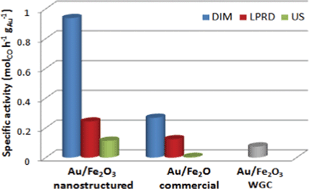Nanostructured iron oxidecatalysts with gold for the oxidation of carbon monoxide
Abstract
A commercial

* Corresponding authors
a
Laboratório de Catálise e Materiais, Associate Laboratory LSRE/LCM, Departamento de Engenharia Química, Faculdade de Engenharia, Universidade do Porto, Porto, Portugal
E-mail:
sonia.carabineiro@fe.up.pt
Fax: +351 22 5081449
Tel: +351 22 5081582
b Universidad Nacional Autónoma de México, Centro de Nanociencias y Nanotecnología, Carretera Tijuana-Ensenada, Ensenada, Baja California, Mexico
c Universidade de Trás-os-Montes e Alto Douro, CQVR Centro de Química–Vila Real, Departamento de Química, Vila Real, Portugal
A commercial

 Please wait while we load your content...
Something went wrong. Try again?
Please wait while we load your content...
Something went wrong. Try again?
S. A. C. Carabineiro, N. Bogdanchikova, P. B. Tavares and J. L. Figueiredo, RSC Adv., 2012, 2, 2957 DOI: 10.1039/C2RA00724J
To request permission to reproduce material from this article, please go to the Copyright Clearance Center request page.
If you are an author contributing to an RSC publication, you do not need to request permission provided correct acknowledgement is given.
If you are the author of this article, you do not need to request permission to reproduce figures and diagrams provided correct acknowledgement is given. If you want to reproduce the whole article in a third-party publication (excluding your thesis/dissertation for which permission is not required) please go to the Copyright Clearance Center request page.
Read more about how to correctly acknowledge RSC content.
 Fetching data from CrossRef.
Fetching data from CrossRef.
This may take some time to load.
Loading related content
